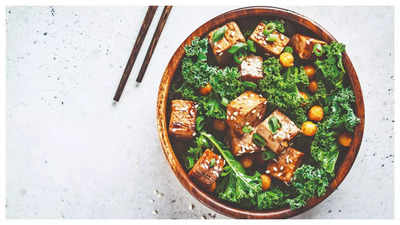Trending
Sustainable, versatile: Tofu can be the star of any cuisine
This versatile ingredient is turning every menu on its head

Fry or grill: Grilled tofu with sesame

Alternative for eggs: Scrambled tofu crispy toast
A breakfast tofu scramble, tofu and mushroom rice bowls for lunch or a quick tomato and ginger braised tofu for dinner – this versatile ingredient is turning every menu on its head and how! Whether you are going fashionably vegan or wish to go beyond the worn-out paneer, the “beautifully mild” tofu is increasingly becoming a staple now. It comes in a variety of forms like puffs, skins, strips and blocks, with texture ranging from silken to extra firm, and it can be used as a plant-based or vegan protein swap in many dishes.
The global tofu market size was valued at USD 2.97 Billion in 2024. Looking forward, IMARC Group estimates the market to reach USD 4.42 Billion by 2033, exhibiting a CAGR of 5.08% from 2025-2033. Asia Pacific currently dominates the market. India’s Tofu Products Market is projected to be worth USD 122.12 million by 2033 and is anticipated to surge at a CAGR of 11.82%.

In desserts: Wedang Tahu, an Indonesian sweet made with tofu, ginger tea with palm sugar
‘Versatile, highly nutritious’
Tofu is considered a versatile ingredient because it has a beautiful mild flavour that readily absorbs the flavours of marinades and sauces. “This quality allows tofu to be used in a wide variety of dishes, from stir-fries and soups to salads, dips, and even desserts. Depending on the tofu type and preparation method; it can be baked, grilled, fried, crumbled, or pureed, making it a great meat substitute for vegetarians and vegans,” says dietitian and nutritionist Sohini Shah.
She adds that “tofu is a highly nutritious plant-based protein source, rich in calcium, and a variety of vitamins and minerals”. “Tofu is relatively low in calories and fat while providing a significant amount of protein, with most of its fat content being heart-healthy polyunsaturated fats; it also stands out due to its high calcium content, which is important for bone health,” explains Sohini.
Adds chef Zarin Mirza, “Tofu is versatile because it works well with different spices and is used as an alternative for meat in different cuisines. Interestingly, one can use different legumes to make tofu; for example, the Burmese use chickpea to make their polenta-like chickpea tofu. Tofu is a cleaner protein with lesser fat. Since the boom of Japanese and other Asian cuisines, tofu is becoming more and more popular, and people are loving it for its sustainability, versatility and nutritional benefits.”
Sohini adds, “Tofu is a sustainable protein source as it has a lower carbon footprint compared to most animal proteins, requires less land and water, generates less waste during production.”

In Indian cuisine: Tofu butter masala
Types and textures
- Silken tofu
Best for: Smoothies, dips, sauces, desserts, and where a creamy texture is desired
- Firm tofu
Best for: Stir-fries, pan-frying, grilling, and dishes where tofu needs to maintain its form
- Extra-firm tofu
Best for: Deep-frying, baking, and where you need tofu to mimic meat texture

Make fast food healthier: Tofu burger with wholegrain buns
How tofu compares to other protein sources
Compared to meat:
Tofu is significantly lower in saturated fat than most animal proteins like chicken or red meats while still providing a substantial amount of protein.Compared to beans:
While beans are also a good plant-based protein source, tofu generally has a higher protein content per serving.Compared to dairy products:
Tofu can be a good alternative to cheese for those avoiding dairy, offering a similar texture with a lower fat content depending on the type.- Inputs by Sohini Shah, registered dietitian and nutritionist
Pro tips:
Pressing is essential:
Before cooking, always press the tofu to remove excess water, using a heavy object with paper towels.Choose the right type
: Different tofu firmness levels are suitable for different dishes. Use extra-firm tofu for frying or baking, firm tofu for soups, and silken tofu for creamy textures.Marinating:
Marinate tofu to add flavour but remember that tofu doesn't absorb marinade as well as meat due to its low porosity.Do not overcook:
Be careful not to overcook tofu, as it can become rubbery.Season properly:
Tofu can be bland on its own, so make sure to add ample flavour with marinades, sauces, and spices.Did you know?
42% consumers in the US said they are increasing their plant-protein consumption for environmental reasons, as per a US Soy Protein Survey conducted in 2023
End of Article
FOLLOW US ON SOCIAL MEDIA
Visual Stories
Tired of too many ads?go ad free now










